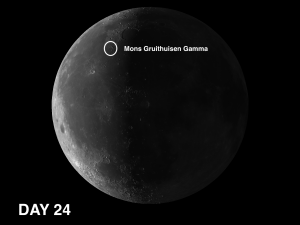 The week of September 23-29 takes us from Day 23 to Day 1. This week we will highlight the lunar dome Mons Gruithuisen Gamma, viewable early Tuesday morning.
The week of September 23-29 takes us from Day 23 to Day 1. This week we will highlight the lunar dome Mons Gruithuisen Gamma, viewable early Tuesday morning.
 Gruithuisen Gamma1: [NW/F5; L=41°W] There is a peninsula-like piece of highland terrain that extends southwest of Sinus Iridum. At the end of this peninsula you will find Mons Gruithuisen Gamma. Next to the so-called Valentine Dome, this is the Moon’s second largest dome. If you can manage to spot the summit crater (3,000 feet in diameter, about one-half an arc-second at the Moon’s mean distance) you will have accomplished a major feat! (This would require at least a 10” telescope and a night of exceptionally steady viewing.)
Gruithuisen Gamma1: [NW/F5; L=41°W] There is a peninsula-like piece of highland terrain that extends southwest of Sinus Iridum. At the end of this peninsula you will find Mons Gruithuisen Gamma. Next to the so-called Valentine Dome, this is the Moon’s second largest dome. If you can manage to spot the summit crater (3,000 feet in diameter, about one-half an arc-second at the Moon’s mean distance) you will have accomplished a major feat! (This would require at least a 10” telescope and a night of exceptionally steady viewing.)
OF ADDITIONAL INTEREST IN SPACE:
The autumnal equinox this year occurs on Monday, September 23. And is the moment when the Sun is directly over the Earth’s equator. As a result, daytime and nighttime are of approximately equal duration.
1Pronounced /GROOT.hoo.zen/
======================
It is highly recommended that you get a copy of Sky and Telescope’s Field Map of the Moon, the very finest Moon map available for use at the telescope. It is available for $10.95 at www.skyandtelescope.com and on Amazon. All features mentioned in this blog will be keyed to the grid on the Field Map and will look like this: Plato: [NW/D9]
Credits:
Courtesy of Gray Photography of Corpus Christi, Texas
Lunar photos: NASA / USGS / BMDO / LROC / ASU / DLR / LOLA / Moon Globe. Used by permission
- Rupes Cauchy: A Best Known Fault on the Moon - July 22, 2024
- Moon Crater Schickard – Crater Floor has Stripes - July 15, 2024
- Moon Craters Langrenus and Vandelinus - July 8, 2024